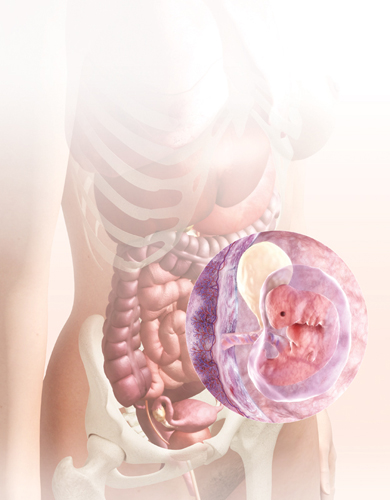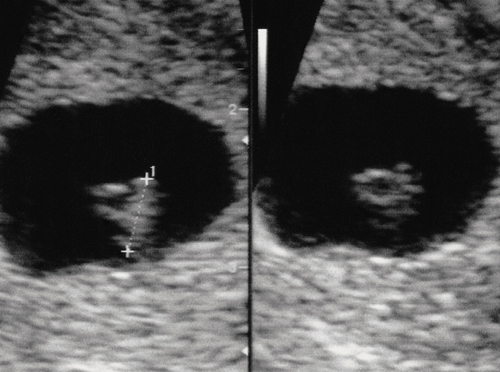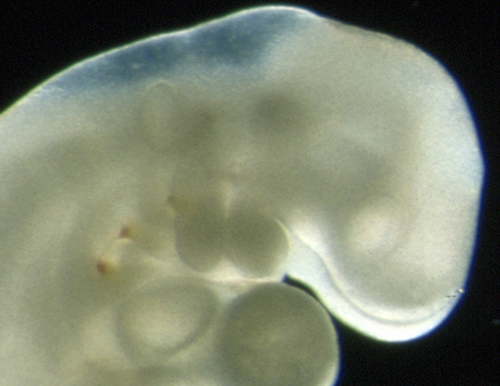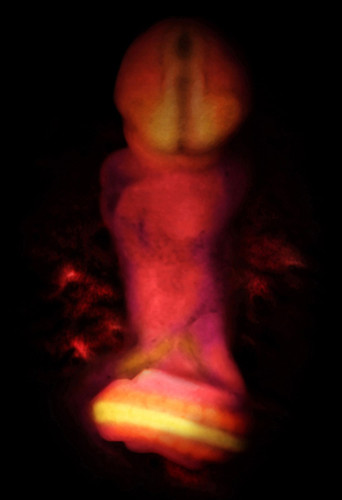Your 6th Week
Not all women start to
feel pregnant this early on. Some experience a twinge of nausea or
breast tenderness, while others notice no changes. Of course, it’s
natural to long for “proof” that your pregnancy is progressing, even if
that happens to be morning sickness. But a lack of symptoms doesn’t mean
something is wrong; it’s all really happening and your baby is going
through some critical stages of development.
NOTE
This week you may notice the first symptoms of pregnancy—if not, don’t worry
Embryo at 6 weeks

You are 5 Weeks and 1 Day 244 days to go…
If you’ve had no symptoms as you enter your 6th week, you may be on the lookout for signs that you are in fact pregnant.
Your baby today
The embryo now has 14 somites—the building blocks of your baby’s
muscular system. The first nine pairs are shown here. The upper part of
the image shows the open end of the neural tube, which, along with the
opening at the base of the spine, has closed.

You and your partner are probably the only people
who know you’re pregnant, and you may still be wondering if it’s real.
At this stage you may not have any symptoms at all, despite the rapidly
changing and growing embryo inside you.
This absence of pregnancy
signs is completely normal and is not a cause for concern. Try to
remember that the majority of pregnancies are without any complications.
It’s normal for a healthy pregnant woman to have a wide range of side
effects or none at all. So don’t worry if you’re feeling great—in fact
count yourself lucky!
Early ultrasound scans
Some women will have an early ultrasound scan, but the majority of women will have one around the 12th week of pregnancy (see You are 11 Weeks and 1 Day).
Early scans are usually done vaginally, with a scanning probe inserted
gently into the vagina. They are performed for the following reasons:
If there is a history of multiple births
in your family (or you have used IVF or another form of assisted
pregnancy), your doctor may want to check the number of fetuses.
If you’ve had a miscarriage in the past, or show signs of cramping or spotting, or more profuse bleeding, a scan can be done to check that there is still a heartbeat.
To establish the cause of vaginal bleeding. Your baby may be healthy, but fibroids or other conditions may be causing you to bleed. This will be addressed by your doctor.
Early vaginal scans do not show a great deal of detail. The sonographer waits until the embryo is in the correct position (left) to be measured.

… Nutritionist
| Q: |
Since being pregnant, I don’t seem to have much of an appetite. Is this normal?
|
| A: |
It is common to not especially want food if you have morning sickness (see You are 5 Weeks and 3 Days).
You may no longer be able to stomach your favorite foods. If you’re not
eating much, it’s important that what you do eat is nutritious. Choose
nutrient-rich dark green leafy vegetables and legumes, and fish (see … Nutrition) since it contains essential fatty acids.
|
Up to 90 percent of your supply of vitamin D depends on adequate exposure to sunlight.
Vitamin D helps your
body absorb calcium, which is vital for the development of your unborn
baby’s skeleton. A daily 15-minute walk outside—with the sun on your
skin—is sufficient; you can also boost your intake of vitamin D by
eating oily fish, eggs, fortified cereals, and bread, and by taking
supplements .
You are 5 Weeks and 2 Days 243 days to go…
There won’t be any visible signs of pregnancy on the outside for some time, but there are many changes taking place inside.
Your baby today
The center of this image shows the baby’s developing
heart(darker gray), a very primitive structure at this stage. The baby’s
head is to the right of the image. The embryo is almost completely
transparent.

At this early stage, all your unborn baby’s needs
will be met by the yolk sac. Attached to the embryo by a connecting
stalk, this essential balloonlike structure indicates the site of your
pregnancy and can usually be seen as early as this week as a sphere
0.1–0.2 in (3–4 mm) across. At first the yolk sac is as large as the
disk of embryonic cells that will eventually become your baby.
Containing cells that
perform a similar function to the liver, the yolk sac releases several
pregnancy hormones and produces the embryo’s first red blood cells.
After week 9 the liver will take over these functions as the yolk sac
gradually disappears and the placenta takes over, by around the 10th
week of pregnancy.
Over the next
seven days, a primitive circulatory system develops, well before any
blood circulates to the placenta in the 10th week. And, by the end of
this week, using the highest quality ultrasound equipment, it is just
possible to see the embryo’s heartbeat. At this early stage, the heart
is simply a tube.
… Nutritionist
| Q: |
Should I be eating for two?
|
| A: |
Unfortunately, pregnancy is by no means a licence to eat
anything and everything you’d like. “Eating for two” is a myth, and if
you do so, you’ll end up consuming too many calories and gaining too
much weight. The best advice is to use your common sense. Studies show
that pregnant women who eat according to their appetite naturally eat
the proper amount and gain a healthy amount of weight.
Caloric needs in
pregnancy vary greatly from woman to woman, depending upon pre-pregnancy
weight and physical activity. In general, energy needs increase by
approximately 300–500 calories per day during pregnancy. In the first
trimester, caloric needs are a bit less, more at the lower end of the
range.
In the first
trimester, when up to 80 percent of women are nauseous or vomiting,
getting enough calories can sometimes be a challenge. Like many pregnant
women, you may feel most nauseous when your stomach is empty. One good
trick is snacking. Eating five small meals rather than three large ones
can be soothing to a nauseous stomach, while at the same time giving you
the calories you need.
|
If you can’t stomach big plates of food, try eating a combination of small portions at mealtimes and as snacks.

You should continue to take a 400 mcg folic acid supplement daily until the 12th week of pregnancy.
This supplementation
is in addition to a well-balanced diet that includes green vegetables
and legumes. Many fortified cereals also contain folic acid, as do some
fruits, such as oranges, papaya, and bananas.
You are 5 Weeks and 3 Days 242 days to go…
Morning sickness is one of the most common and least welcome symptoms of pregnancy.
Your baby today
A front view of the embryo: the head region is bent downward so
that the central nervous system can be seen. The tubelike structure in
the head region is the developing spinal cord. The tail of the embryo is
curving upward.

Feeling sick and vomiting
are common symptoms of early pregnancy. There are various theories to
explain why morning sickness occurs; one is that it’s due to the rising
levels of hCG (human chorionic gonadotrophin) hormone during the first
trimester. Morning sickness, unfortunately, doesn’t only happen before
breakfast; in fact it can happen at any time of day and more than once
in 24 hours.
One of the greatest
challenges of early pregnancy is keeping it a secret from colleagues.
If you have to keep rushing to the bathroom to vomit, people are likely
to become suspicious. They may also notice that you look unwell or are
more tired than usual. To help you handle this, you may want to tell one
or two colleagues or your boss. You could ask them to keep it a secret
for the time being. It’s a good idea to keep some face wipes,
toothpaste, and a toothbrush in your drawer, together with any snacks
that you have found help to ease your nausea.
If you’re finding it
difficult to handle your vomiting, or are worried you are vomiting too
much, seek advice from your doctor. Rarely, the sickness can become more
serious and require medical treatment (see You are 8 Weeks and 3 Days).
… Health
Ease the nausea
Unfortunately there is no definitive cure-all for morning sickness, though you could try the following natural remedies:
Eat little and often—having low blood-sugar levels may make the nausea worse so even if you feel sick, eating small snacks may help.
Try eating a plain cookie or cracker first thing in the morning before you get out of bed.
Stick to bland foods such as cereal or toast and avoid eating fatty and oily foods.
Try having foods and drinks that contain ginger (see as a matter of fact) such as gingersnaps or ginger tea.
Drink plenty
if you are vomiting, to avoid becoming dehydrated. Put a bottle of
water in the fridge and sip it gradually throughout the day. If you feel
you are getting dehydrated, for example if your urine is getting very
concentrated, you may need to see a doctor.
If the nausea or vomiting is too much to bear, then consult your doctor, who will be able to prescribe anti-nausea medications.
Ginger has been shown in studies to help with pregnancy-induced nausea.
One study found that the
decrease in nausea happened four days after including ginger in the
diet daily; so don’t give up if you don’t get relief right away. Try
crystallized ginger chews or tasty ginger cookies; drink soothing ginger
tea; and try cooking with fresh ginger. Be aware that most ginger ale
does not contain real ginger, so is unlikely to ease nausea.
Ginger contains properties that help to ease nausea. Put a plate of cookies on your bedside table, and nibble them before you get out of bed.

A Changing World
The family is an
ever-changing unit and has undergone some major shifts in the past two
decades. Although times have changed, your role as a parent is the same
as ever: to give your child consistent love, loyalty, and care.
The family today
Today, there are many
varieties of family life. Although studies report on the problems of
modern childhood, children are familiar with and tolerant of different
cultures, and living and working practices.
Mature moms
The number of births to
women in the US between 35–39 has risen 52 percent since 1990; the birth
rate in women 40–44 has risen 65 percent since 1990 and is at an
all-time high. Benefits are that older women are more likely to be
settled, financially stable, and mature.
Single parenting
Single moms in the US
have risen from 1 percent in 1971, to 12.5 percent in 2007. There’s no
doubt that children in single-parent families can be disadvantaged, but
it’s thought that much of this is due to financial constraints, and that
those who have adequate socioeconomic resources do well.
Stepfamilies
Stepfamilies are
the fastest-growing family type. It’s thought that at least 1 in 3
children will have a stepfamily situation within their lifetime.
Siblings may be of wildly different ages, or of the same age; these are
unique and beneficial relationships for all children.
Modern dads
Dads today are more
involved in family life. Some 93 percent attend the birth (compared to 5
percent in 1965), and over 70 percent take time off after the birth. In
the 1970s, dads of children under five devoted less than 15 minutes a
day to child-related activities, compared to over two hours by the
1990s. Research shows that children whose dads spend considerable time
with them do well educationally and at work.
Child care
This is a necessity in
most families. Studies show that good care outside the family has a
positive impact on social skills, intellect, and language. Grandparents
care for about 30 percent of US babies. A good grandparent relationship
provides stability, family values, and is thought to improve cognitive
development.
Multiple cultures
Your baby will live in a
multicultural society. This affects educational experience and
friendships, and there’s a strong chance a child will be cared for by
someone from another culture at some point in her childhood.
The statistics
Changing family life
The statistics below reveal how family life has changed over decades.
In the US, 64 percent of moms with children under the age of six work; in the UK, 55 percent of mothers of children under five work (compared with around 25 percent in 1975).
About 25 percent of children under five with working moms are cared for full-time by dad and 30 percent of working parents share child care.
About 25 percent of married moms stays at home full time with the children.
Today, around 25 percent of children live in one-parent families, of which about 9 percent have a single dad at the helm.
Around 25 percent of babies in the UK are
born to immigrant moms, and in some parts of the country up to a third
of all babies are born to ethnic minority families—a figure that is
similar in New Zealand and Australia. In the US, about a third of all
children are minorities.
More than 41 percent of babies in the UK are
born to unmarried women; in the US, 37 percent of babies are born out
of wedlock. This trend is echoed throughout the West, and the numbers
are steadily rising.
One in every 100 babies grows up in a household with same-sex parents.
The gender gap
Boys versus girls
Historically, about 106 boys have been born for every 100 girls—a
phenomenon believed to be nature’s way of compensating for the fact
that males are more likely to be killed through conflicts. But ratios
are changing with girls outnumbering boys. One factor may be increased
stress (women under stress produce more girls than boys). However, the
most important contributor is now thought to be the number of
gender-bending chemicals in our environment, such as synthetic
estrogens, PCBs (polychlorinated biphenyls), and pesticides.